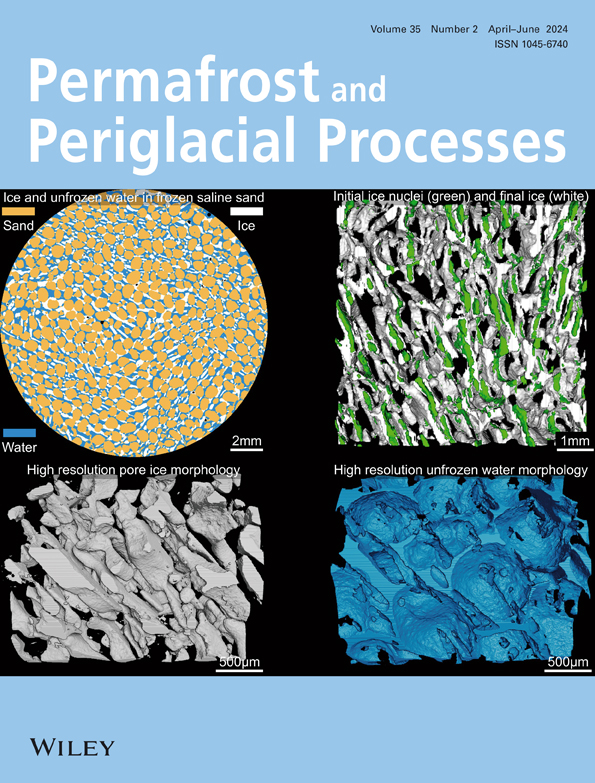加拿大西北部沿海冰楔的离子地球化学:来自海洋气溶胶的贡献及其对冰楔古气候解释的影响
IF 3.3
3区 地球科学
Q2 GEOGRAPHY, PHYSICAL
引用次数: 1
摘要
冰楔是永久冻土区地面冰的特征,主要由季节性积雪的融水形成。冰楔氧和氢稳定同位素已用于冬季古地温重建;然而,直到最近,冰楔的离子地球化学很少被分析为潜在的古气候代用物。这种可能性对于位于沿海地区的冰楔来说是最大的,因为海洋气溶胶是积雪杂质的主要来源。在这里,我们评估了加拿大西北北极(波弗特海岸)沿海冰楔离子浓度的来源和完整性,以评估冰楔作为海洋气溶胶档案的使用。与区域可比积雪相比,Cl−、Na+、Br−、SO42−、Ca2+和Mg2+的离子浓度非常相似,Cl−/Na+比值与大块海水相似(1.80比1.79),表明海洋气溶胶可能来自海冰吹雪事件期间海盐气溶胶产生的SO42−值相对于Na+的减少,可能是离子浓度的主要贡献者。利用先前建立的冰楔线性年龄模型,建立了一个跨越~ 4600 ~ ~700年的连续离子记录。Cl -和Na+浓度显示,在全新世晚期,Cl -和Na+浓度出现了强烈和持续的增加,这被认为是由于海岸侵蚀导致海岸与海岸之间的距离缩短了1公里。该研究提出了一种新的冰楔地球化学数据解释,并代表了全新世首个冰楔离子记录。本文章由计算机程序翻译,如有差异,请以英文原文为准。
Ion geochemistry of a coastal ice wedge in northwestern Canada: Contributions from marine aerosols and implications for ice‐wedge paleoclimate interpretations
Ice wedges are a characteristic ground ice feature in permafrost regions that form primarily from the meltwater of the seasonal snowpack. Ice‐wedge oxygen and hydrogen stable isotopes have been used in winter paleotemperature reconstructions; however, until recently, the ion geochemistry of ice wedges has rarely been analyzed as a potential paleoclimate proxy. This potential is greatest for ice wedges located in coastal regions, where marine aerosols are the dominant contributor to snowpack impurities. Here, we evaluate the source and integrity of ionic concentrations of a coastal ice wedge in the northwestern Canadian Arctic (Beaufort Sea coast) to evaluate the use of ice wedges as a marine aerosol archive. Comparison to a regionally comparable snowpack reveals remarkably similar ionic concentrations for Cl−, Na+, Br−, SO42−, Ca2+, and Mg2+, with a Cl−/Na+ ratio similar to bulk seawater (1.80 vs. 1.79 in seawater), suggesting that marine aerosols, probably from sea salt aerosol production during blowing snow events over sea ice as indicated by depleted SO42− values relative to Na+, are probably the dominant contributor to ion concentrations. A previously established linear age model for the ice wedge is used to develop a continuous ion record spanning ~4,600 to ~700 yr b2k. Cl− and Na+ concentrations reveal a strong and continuous increase in concentrations over the late Holocene, thought to be driven by reduced distance‐to‐coast of up to 1 km as a result of coastal erosion. This study presents a novel interpretation of ice‐wedge geochemical data and represents the first Holocene ice‐wedge ion record.
求助全文
通过发布文献求助,成功后即可免费获取论文全文。
去求助
来源期刊
CiteScore
9.70
自引率
8.00%
发文量
43
审稿时长
>12 weeks
期刊介绍:
Permafrost and Periglacial Processes is an international journal dedicated to the rapid publication of scientific and technical papers concerned with earth surface cryogenic processes, landforms and sediments present in a variety of (Sub) Arctic, Antarctic and High Mountain environments. It provides an efficient vehicle of communication amongst those with an interest in the cold, non-glacial geosciences. The focus is on (1) original research based on geomorphological, hydrological, sedimentological, geotechnical and engineering aspects of these areas and (2) original research carried out upon relict features where the objective has been to reconstruct the nature of the processes and/or palaeoenvironments which gave rise to these features, as opposed to purely stratigraphical considerations. The journal also publishes short communications, reviews, discussions and book reviews. The high scientific standard, interdisciplinary character and worldwide representation of PPP are maintained by regional editorial support and a rigorous refereeing system.

 求助内容:
求助内容: 应助结果提醒方式:
应助结果提醒方式:


